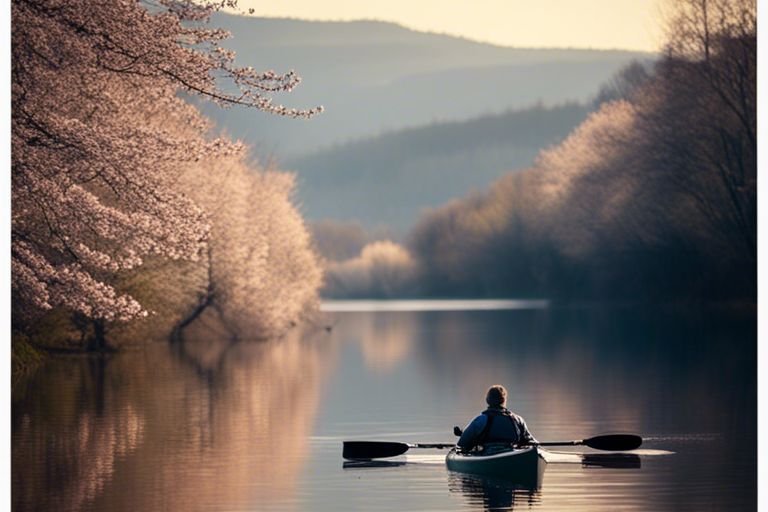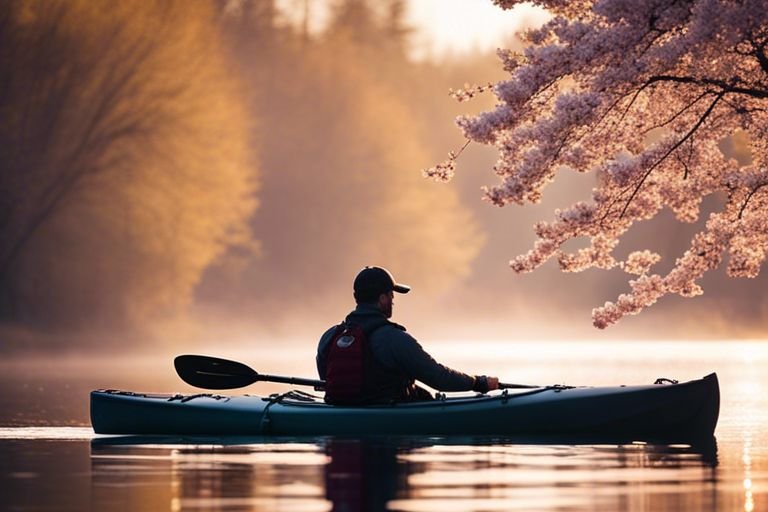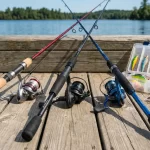I’ve spent 25 years on the water, and I can tell you that spring is a game-changer for kayak anglers. The fish are hungry, the water’s warming up, and the possibilities are endless.
But to maximize your catch, you need to adapt your tactics to the changing season. Don’t get left behind – grab your paddle and join me as we explore the secrets to successful kayak fishing in this season of renewal.
From utilizing technology to your advantage to prioritizing safety, I’ll share my top tips to help you make the most of your spring kayak fishing trip.
And if you’re looking for more expert advice, check out this thread on Reddit for even more tips from experienced kayak anglers.
Key Takeaways:
- Adapt to changing fish behavior: As the water warms, fish will move from deeper winter haunts to shallower areas seeking food and spawning grounds, so adjust your tactics accordingly.
- Utilize technology: A fish finder and GPS unit can help you identify underwater structures, locate baitfish, and pinpoint productive spots.
- Choose the right lures: Early in the season, use slow-moving presentations like jigs and suspending jerk baits, and switch to more aggressive presentations like crankbaits and topwater lures as the water warms.
- Prioritize safety: Always check the forecast, dress in layers, wear a life jacket and carry necessary safety gear to ensure a safe and successful fishing trip.
- Take advantage of kayak versatility: Kayaks allow you to navigate tight spaces and reach hard-to-access areas where fish often congregate, making them ideal for spring kayak fishing.
Seasonal Advantages

As I’ve learned over the years, spring kayak fishing offers a unique set of advantages for those willing to adapt their tactics and embrace the change.
So, what makes spring so special?
Hungry Fish
On the heels of a long winter, fish are hungry and eager to feed, making them more likely to strike your lure. This is especially true for species like bass, trout, and walleye, which tend to congregate in shallower waters as the water warms.
With their metabolisms kicking into high gear, they’re more active and aggressive, increasing your chances of landing a big catch.
Additionally, the changing water temperatures trigger a shift in their behavior, making them more susceptible to certain lures and presentations.
By understanding these patterns and adapting your tactics accordingly, you can capitalize on this seasonal advantage and fill your net with some impressive catches.
Spawning Behavior
Seasonal changes trigger spawning behavior in many species, bringing them into shallower waters and making them more accessible to kayak anglers.
This is a critical period, as fish are more concentrated and predictable, allowing you to target specific areas and increase your chances of success.
As the water warms, species like bass will move from their deeper winter haunts to shallower areas seeking food and spawning grounds.
By understanding these patterns and targeting areas with suitable structures, such as submerged vegetation, rocks, or sunken logs, you can increase your chances of landing a trophy catch.
Plus, this is a great time to experiment with different lures and presentations, as fish are more likely to be aggressive and responsive to certain stimuli.
By paying attention to the subtle changes in their behavior and adapting your tactics accordingly, you can stay one step ahead of the game and maximize your catch.
Versatility of Kayaks
An often-overlooked advantage of kayak fishing is the versatility of kayaks themselves.
Unlike larger boats, kayaks allow you to navigate tight spaces, explore secluded coves, and reach those hard-to-access areas where fish often congregate.
This is especially true in spring when fish are more likely to be concentrated in shallower waters.
By leveraging the agility and maneuverability of your kayak, you can target areas that would be impossible to reach with a larger boat.
This allows you to get up close and personal with your quarry, increasing your chances of landing a big catch.
The versatility of kayaks also extends to their ability to be customized and adapted to your specific fishing style.
By adding accessories like rod holders, fish finders, and storage compartments, you can create a fishing platform that’s tailored to your unique needs and preferences.
Overcoming Spring Challenges
One of the most significant advantages of spring kayak fishing is the opportunity to catch hungry fish.
However, this season also presents unique challenges that require anglers to be adaptable and prepared.
Adapting to Weather Conditions
For kayak anglers, spring weather can be unpredictable and rapidly changing. One moment it’s sunny and calm, and the next, a strong wind or thunderstorm rolls in.
To overcome this challenge, I always check the forecast before heading out and plan my trip accordingly. It’s vital to be prepared for changing weather conditions by dressing in layers and bringing the necessary gear, such as a rain jacket or windbreaker.
Additionally, I make sure to keep a close eye on the sky and water conditions, watching for signs of changing weather.
If a storm appears to be approaching, I’ll quickly paddle back to shore or seek shelter in a nearby cove. Note, that safety should always be your top priority when kayak fishing.
Fluctuating Water Temperatures
Fluctuating water temperatures can significantly impact fish behavior and feeding patterns.
As the water warms, fish will move from their deeper winter haunts to shallower areas seeking food and spawning grounds.
Water Temperature Ranges and Fish Behavior
| Water Temperature Range | Fish Behavior |
|---|---|
| 40°F – 50°F | Fish are sluggish and inactive, seeking deeper waters |
| 50°F – 60°F | Fish begin to move into shallower waters, seeking food and spawning grounds |
| 60°F – 70°F | Fish are active and feeding aggressively, often in shallower waters |
Plus, understanding these temperature ranges can help you choose the right lures and presentations to entice hungry fish.
For example, in cooler water temperatures, slow-moving presentations like jigs and creature baits can be deadly.
As the water warms, you can switch to more aggressive presentations like crankbaits and topwater lures.
Increased Boat Traffic
An increase in boat traffic can make it challenging to find productive fishing spots and avoid collisions on the water.
To overcome this challenge, I try to plan my trips during off-peak hours, such as early morning or late evening, when there are fewer boats on the water.
Increased boat traffic also means it’s vital to be more vigilant and aware of your surroundings. Always keep an eye out for other boats and watercraft, and be prepared to adjust your course or slow down if necessary.
Increased boat traffic can also lead to disturbed water, making it harder for fish to find your lure.
To combat this, try using lures that create a lot of noise or disturbance, such as spinnerbaits or crankbaits, to attract fish in noisy waters.
Utilizing Technology

Unlike traditional fishing methods, modern kayak fishing has evolved to incorporate technology that can significantly improve your chances of success.
Fish Finders
One of the most valuable tools in my kayak fishing arsenal is a fish finder. This device allows me to identify underwater structures, locate baitfish, and pinpoint the thermocline – that magical depth where warmer water meets cooler water, often attracting a concentration of fish.
With a fish finder, I can quickly scan the water column, identifying areas of high activity and adjusting my presentation accordingly. This can be especially useful in spring when fish are more scattered and less predictable.
When choosing a fish finder, look for a model with high-resolution imaging, GPS capabilities, and adjustable sensitivity settings.
These features will enable you to accurately identify targets, mark productive spots, and navigate back to them later.
GPS Units
A vital companion to my fish finder is a reliable GPS unit. This device allows me to mark productive spots, track my drifts, and navigate back to those honeyholes time and time again.
With a GPS unit, I can create a mental map of the lake, identifying areas of high activity and avoiding those that are less productive.
The GPS unit also helps me to track my speed and direction, ensuring that I’m presenting my lure at the optimal pace and angle.
This is especially important in spring when fish are more finicky and require a more precise presentation.
The GPS unit is also useful for tracking my route, allowing me to identify patterns and trends in fish behavior.
By analyzing my tracks, I can identify areas where fish are more likely to congregate, such as structural features or baitfish schools.
Marking Productive Spots
One of the most valuable features of my GPS unit is the ability to mark productive spots. By dropping a waypoint at a location where I’ve caught fish, I can quickly return to that spot later and target the same area.
This is especially useful in spring when fish are more scattered and less predictable.
When marking productive spots, I make sure to include notes about the location, including the depth, structure, and any notable features. This helps me to refine my search pattern and target the most productive areas.
A key benefit of marking productive spots is that it allows me to build a mental map of the lake, identifying areas of high activity and avoiding those that are less productive.
This mental map helps me to make more informed decisions about where to fish, and when to move on to a new location.
Adapting to Changing Fish Behavior
Once again, I find myself on the water, surrounded by the sights and sounds of spring. As the seasons change, so do the habits of the fish. And as kayak anglers, it’s our job to adapt and stay one step ahead of them.
If you’re new to kayak fishing, be sure to check out Best Kayak Fishing Tips to Get Started.
Moving from Deeper Waters
Changing water temperatures trigger a shift in fish behavior, causing them to move from their deeper winter haunts to shallower areas seeking food and spawning grounds.
As the water warms, species like bass will begin to migrate toward structures like rocks, weed beds, and sunken logs. These areas provide ambush points and shelter from predators, making them ideal locations to target.
When targeting these areas, it’s important to adjust your presentation accordingly. Slow-moving lures like jigs and creature baits can be deadly in these situations, as they allow the fish to find and strike the lure in their comfort zone.
Seeking Food and Spawning Grounds
Grounds for excitement are being laid as the fish begin to seek out food and spawning grounds. This is a critical period, as the fish are more active and aggressive, making them more susceptible to being caught.
It’s during this time that I focus on areas with abundant baitfish, as these will attract larger predators. Look for areas with structural features like drop-offs, weed lines, and sunken logs, as these provide ambush points and shelter from predators.
When targeting these areas, it’s important to use lures that mimic the size, shape, and color of the local baitfish. This will increase your chances of success, as the fish are more likely to strike a lure that resembles their natural food source.
Tracking Water Temperature Changes
Behavior patterns can be influenced by even the slightest changes in water temperature.
As the water warms, fish become more active and aggressive, making them more susceptible to being caught.
Water Temperature Ranges and Corresponding Fish Behavior
| Water Temperature Range | Corresponding Fish Behavior |
|---|---|
| 40°F – 50°F | Fish are sluggish and inactive, seeking deeper waters for refuge. |
| 50°F – 60°F | Fish begin to move towards shallower areas, seeking food and spawning grounds. |
| 60°F – 70°F | Fish are active and aggressive, feeding heavily on baitfish and other prey. |
A deeper understanding of these temperature ranges and corresponding fish behavior allows me to adjust my tactics and stay one step ahead of the fish.
Note, that tracking water temperature changes is crucial to success in spring kayak fishing.
By understanding how these changes affect fish behavior, you can adjust your tactics and increase your chances of landing that trophy catch.
Effective Lure Selection
Many kayak anglers will agree that selecting the right lure is crucial to success on the water.
In the spring, this is especially true as fish are transitioning from their winter patterns to more active feeding behaviors.
Slow-Moving Presentations
Presentations that mimic the slow, deliberate movements of baitfish or injured prey can be extremely effective in the early spring when water temperatures are still cool.
Lures like jigs, creature baits, and suspending jerk baits are great options for this time of year. These lures allow you to present your offering in a subtle, non-threatening way that can entice even the most finicky fish.
Remember to keep your movements slow and deliberate, as fish are still adjusting to the changing water temperatures.
In my experience, slow-moving presentations are particularly effective in areas with submerged structures like rocks, weed beds, or sunken logs. These areas tend to attract baitfish, which in turn attract larger predators.
By presenting your lure in a way that mimics the natural movement of these baitfish, you can increase your chances of getting a strike.
Aggressive Presentations
The warmer water temperatures of late spring bring with them a change in fish behavior. As fish become more active, they begin to seek out more energetic prey, and that’s where aggressive presentations come into play.
Lures like crankbaits, spinnerbaits, and topwater lures are designed to mimic the rapid movements of fleeing baitfish or injured prey.
These lures are perfect for covering large areas quickly and triggering reaction strikes from active fish.
I’ve found that aggressive presentations are particularly effective in areas with open water or structural features like drop-offs or weed lines.
These areas tend to attract more active fish, and the rapid movements of these lures can trigger a strike from even the most aggressive predators.
Understanding the triggers that drive fish behavior is key to selecting the right lure for the job.
In the spring, fish are driven by hunger and instinct, so lures that mimic their natural prey or trigger a reaction strike tend to be the most effective.
Experimenting with Colors and Sizes
Working with different colors and sizes is important to finding what works best in your local waters. Don’t be afraid to experiment and try new things – it’s often the unexpected combination that produces the best results.
I like to start with lures that mimic the local baitfish, using colors and patterns that match the natural environment. From there, I’ll experiment with different sizes and presentations to see what works best.
With practice and patience, you’ll develop a sense of what works best in your local waters. Do not forget, that the key to success is adaptability – be willing to try new things and adjust your approach as the fish change their behavior.
Effective lure selection is all about understanding the behavior of the fish and presenting your offering in a way that triggers a strike.
By experimenting with different colors, sizes, and presentations, you can increase your chances of success on the water.
Safety First

Now, before we probe the nitty-gritty of spring kayak fishing, let’s talk about the most critical aspect of our time on the water: safety.
Checking the Forecast
On the day of your trip, I always check the weather forecast multiple times. Spring weather can be notoriously unpredictable, and you don’t want to find yourself caught off guard in the middle of a sudden storm.
Make sure to check the wind direction and speed, as well as any potential rain or thunderstorm warnings. A glance at the radar can also give you an idea of any potential weather systems moving into the area.
Understanding the weather conditions will help you plan your trip accordingly. If there’s a chance of strong winds or thunderstorms, you may want to consider postponing your trip or altering your route to avoid exposed areas.
Essential Safety Gear
Essential safety gear is not just a nice-to-have; it’s a must-have. I always carry a whistle, a first-aid kit, and a waterproof bag for my phone. These items may seem simple, but they can be lifesavers in an emergency.
A whistle can help you signal for help if you’re stranded or lost, while a first-aid kit can provide basic medical supplies in case of an accident.
Understanding the importance of safety gear is crucial. You never know when you might need it, and it’s always better to be prepared.
Prioritizing a Safe Return
Safety isn’t just about preparing for emergencies; it’s also about prioritizing a safe return to shore. The most important thing is to stay alert and aware of your surroundings, especially when paddling back to the launch.
Fatigue can set in quickly, especially after a long day of fishing, so make sure to take regular breaks and stay hydrated.
The key to a safe return is to plan. Let someone know your float plan, including where you’re going and when you expect to return. This way, if something does happen, someone will know where to look for you.
Final Words
Following this guide, I’m confident you’ll be well on your way to a successful spring kayak fishing season. Remember to stay adaptable, utilize technology to your advantage, and prioritize safety above all else. With these tips in mind, you’ll be reeling in fish in no time.
And if you’re looking for more insights into the world of kayak fishing, be sure to check out Spring provides some great kayak fishing, where you’ll find even more expert advice and tips to help you make the most of your time on the water.
As I push off from the shore and glide back into the serene morning calm, I’m reminded of why I love spring kayak fishing so much. It’s a time of renewal, of possibility, and endless opportunity.
So grab your gear, get out there, and make the most of this incredible season. Tight lines, and I’ll see you on the water!








